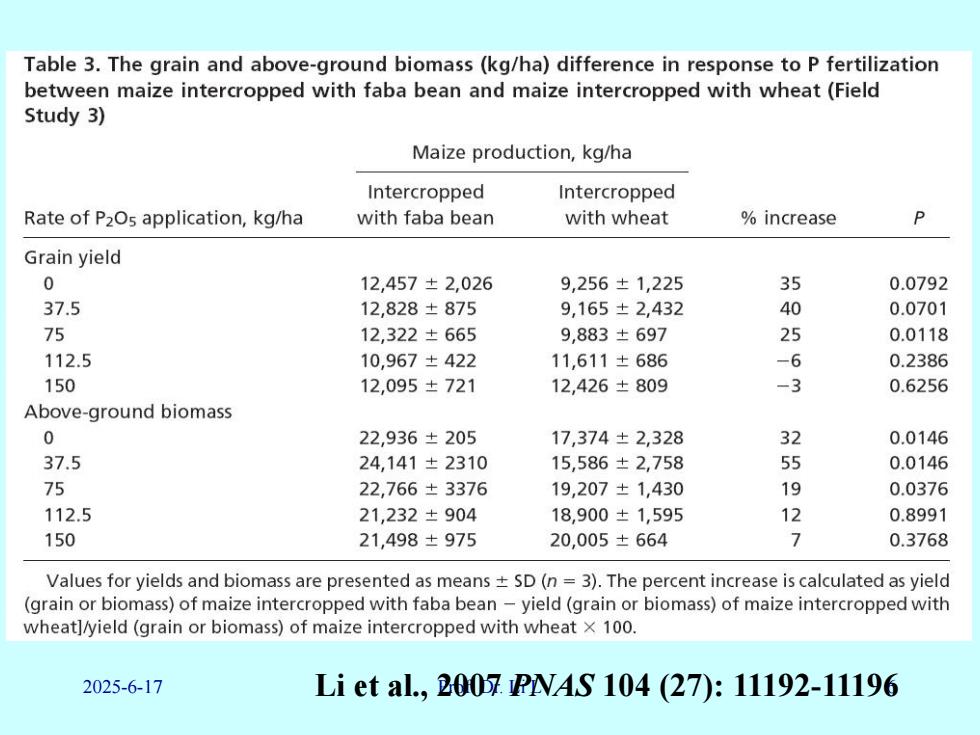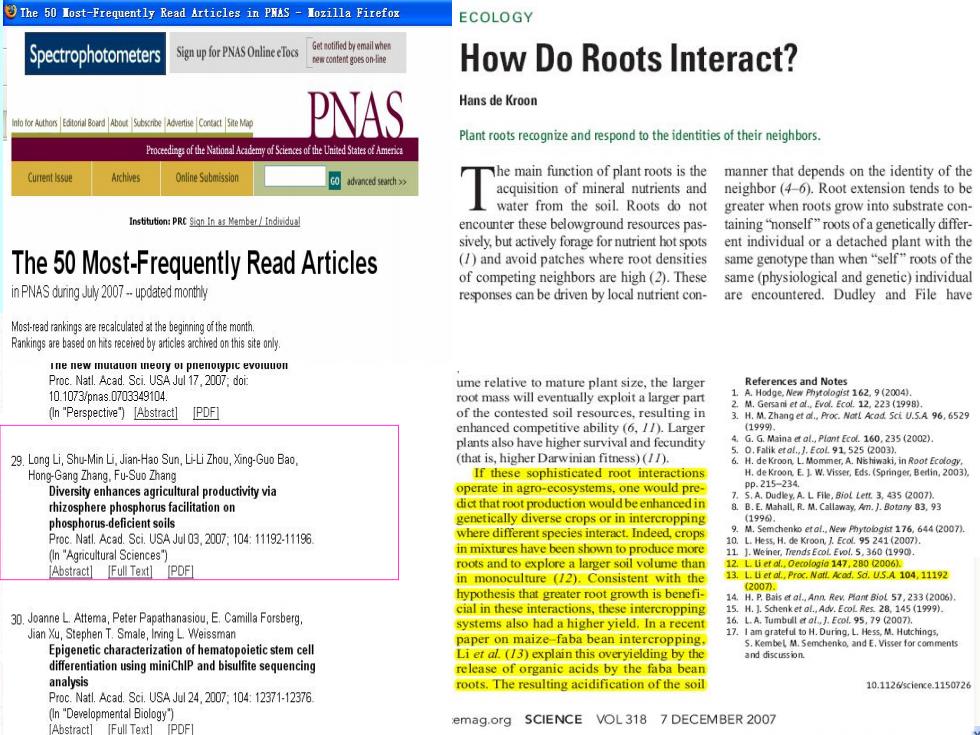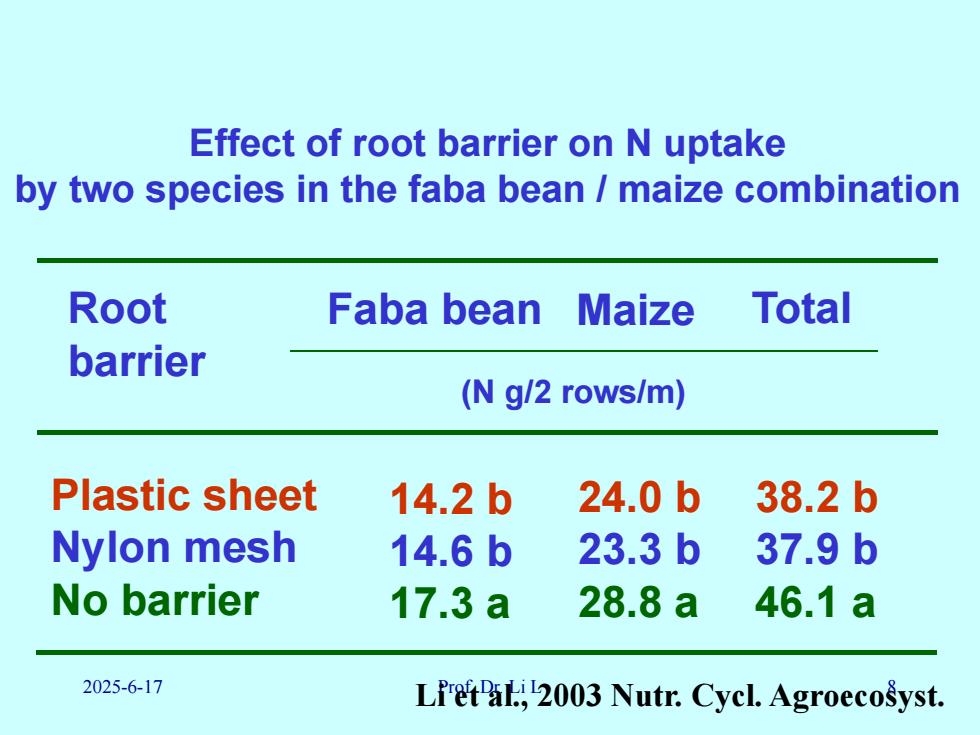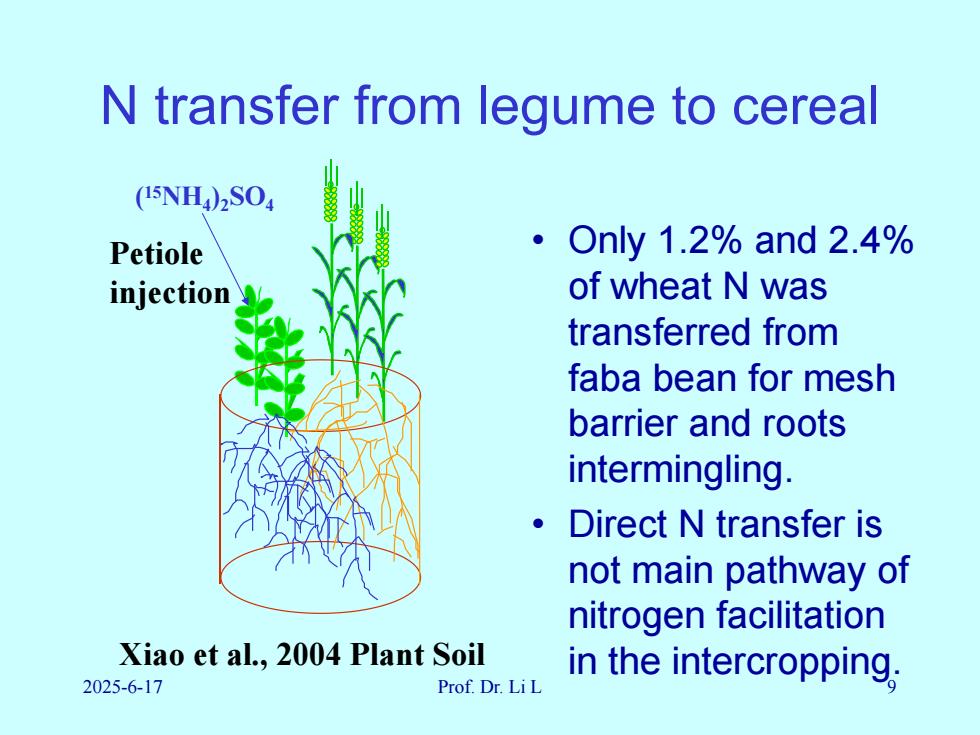
Table 3.The grain and above-ground biomass (kg/ha)difference in response to P fertilization between maize intercropped with faba bean and maize intercropped with wheat(Field Study 3) Maize production,kg/ha Intercropped Intercropped Rate of P2Os application,kg/ha with faba bean with wheat increase Grain yield 0 12,457±2,026 9,256±1,225 35 0.0792 37.5 12,828±875 9,165±2,432 40 0.0701 75 12,322±665 9,883±697 25 0.0118 112.5 10,967±422 11,611±686 6 0.2386 150 12,095±721 12,426±809 -3 0.6256 Above-ground biomass 0 22,936±205 17,374±2,328 32 0.0146 37.5 24,141±2310 15,586±2,758 55 0.0146 75 22,766±3376 19,207±1,430 19 0.0376 112.5 21,232±904 18,900±1,595 12 0.8991 150 21,498±975 20,005±664 0.3768 Values for yields and biomass are presented as means +SD(n=3).The percent increase is calculated as yield (grain or biomass)of maize intercropped with faba bean-yield(grain or biomass)of maize intercropped with wheat]/yield(grain or biomass)of maize intercropped with wheat x 100. 2025-6-17 Li et al.,200.PWAS104(27):11192-11196
2025-6-17 Li et al., 2Pr0of0. D7r. LPi NL AS 104 (27): 11192-111966

The 50 Iost-Frequently Read Articles in PNAS-Iozilla Firefox ECOLOGY Spectrophotometers Sign up for PNAS OnlineeTocs toiedbymalwhe 2stenteMgo60ne How Do Roots Interact? 曲8o时bo5 Cont9e PNAS Hans de Kroon Plant roots recognize and respond to the identities of their neighbors. ofthe Natncdemy of fthe UniteStaeAm Curent issue Archives OnliheSwtmsslon he main function of plant roots is the manner that depends on the identity of the acquisition of mineral nutrients and neighbor (46).Root extension tends to be water from the soil.Roots do not greater when roots grow into substrate con- Institution:PRC Signnas mber/Indiidual encounter these belowground resources pas- taining onself"roots of a genetically differ- sively,but actively forage for nutrient hot spots ent individual or a detached plant with the The 50 Most-Frequently Read Articles (/and avoid patches where root densities same genotype than when“self”roots of the of competing neighbors are high(2).These same (physiological and genetic)individual inPNAS dungJuly 2007updated mont responses can be driven by local nutrient con- are encountered.Dudley and File have Mlosteadrankingsaerecaltuitedathetegnimgcthemonth Rankings are basedtsreced byaricsite ine new mutuon meory o pnenotypic evoruuon Proc.Natl.Acad.Sci.USA Jul 17,2007:doi: ume relative to mature plant size,the larger 10.1073pnas.0703349104 root mass will eventually exploit a larger part 1 (In "Perspective)[Abstract][PDF] of the contested soil resources,resulting in 2 enhanced competitive ability (6,1/).Larger plants also have higher survival and fecundity G.G.Maina et ol,Plant Ecol.160,235 (2002). 9.LongLi,Shu-Min Li,Jian-Hao Sun,Li-Li Zhou,Xing-u Bao, (that is,higher Darwinian fitness)(). 56 Hong-Gang Zhang.Fu-Suo Zhang If these sophisticated root interactions 2123 Diversiytivity vi operate in agro-ecosystems.one would pre- rhizosphere phosphorus facilitation on dict that root production would be enhanced in 7.S.A.Dudley.A.L Flle,BfoL Lert.3,435 (2007). 8.B.E.Mahall.R.M.Callaway.Am.).Botony 83.93 phosphorus-deficient soils genetically diverse crops or in intercropping Proc.Natl.Acad.Sci.USA Jul 03,2007:104:11192-11196. where different species interact.Indeed,crops New Phytolog176,644(2007 n1Ea952412007 In "Agricultural Sciences") in mixtures have been shown to produce more 11 )Weiner,Trends EcoL Evol.5.360 (1990). Abstract][Full Text][PDF] roots and to explore a larger soil volume than in monoculture (12).Consistent with the L.U et al,Proc.Natl.Acod.So.US.A 104,11192 hypothesis that greater root growth is benefi- 3.e LAltema,Peter Papathanasiou,E.Camilla Forsberg, cial in these interactions,these intercropping systems also had a higher yield.In a recent Jian Xu,Stephen T.Smale,Irving L.Weissman paper on maize -faba bean intercropping. Epigenetic characterization of hematopoietic stem cell nd ng5 Li et al.(13)explain this overyielding by the differentiation using miniChlP and bisulfite sequencing release of organic acids by the faba bean analysis roots.The resulting acidification of the soil 10.1126ceme.1150726 P10c.Natl.Acad.Sci.USA Jul24,2007:104:12371-12376 (In"Developmental Biology) Abstract]IFull Text][PDF] emag.org SCIENCE VOL 318 7 DECEMBER 2007
2025-6-17 Prof. Dr. Li L 7

Effect of root barrier on N uptake by two species in the faba bean maize combination Root Faba bean Maize Total barrier (N g/2 rows/m) Plastic sheet 14.2b 24.0b 38.2b Nylon mesh 14.6b 23.3b 37.9b No barrier 17.3a 28.8a 46.1a 2025-6-17 LPet,2003 Nutr.Cycl.Agroecosyst
2025-6-17 Prof. Dr. Li L 8 (N g/2 rows/m) 14.2 b 14.6 b 17.3 a 24.0 b 23.3 b 28.8 a 38.2 b 37.9 b 46.1 a Effect of root barrier on N uptake by two species in the faba bean / maize combination Root Maize Total barrier Faba bean Plastic sheet Nylon mesh No barrier Li et al., 2003 Nutr. Cycl. Agroecosyst

N transfer from legume to cereal (5NH4)2S04 Petiole Only 1.2%and 2.4% injection of wheat N was transferred from faba bean for mesh barrier and roots intermingling. ·Direct N transfer is not main pathway of nitrogen facilitation Xiao et al.,2004 Plant Soil in the intercropping, 2025-6-17 Prof.Dr.Li L
2025-6-17 Prof. Dr. Li L 9 N transfer from legume to cereal • Only 1.2% and 2.4% of wheat N was transferred from faba bean for mesh barrier and roots intermingling. • Direct N transfer is not main pathway of nitrogen facilitation in the intercropping. ( 15NH4)2SO4 Petiole injection Xiao et al., 2004 Plant Soil

Urea-15N (100 mg N kg-1 soil) 140 Wheat 120 Faba bean 1 80 20 0 Plastic Nylon No barrier Plastic sheet Nylon mesh No barrier sheet Mesh Wheat used more soil and fertilizer N,whereas faba bean acquired less N in soil and fertilizer by root interactions 2025-6-17 Prof.Dr.LiL 10
2025-6-17 Prof. Dr. Li L 10 Wheat used more soil and fertilizer N, whereas faba bean acquired less N in soil and fertilizer by root interactions Urea- 15N (100 mg N kg -1 soil) Plastic sheet Nylon mesh No barrier 0 20 40 60 80 100 120 140 Plastic sheet Nylon Mesh No barrier 15 N u p t a k e (m g / p o t)Faba bean Wheat